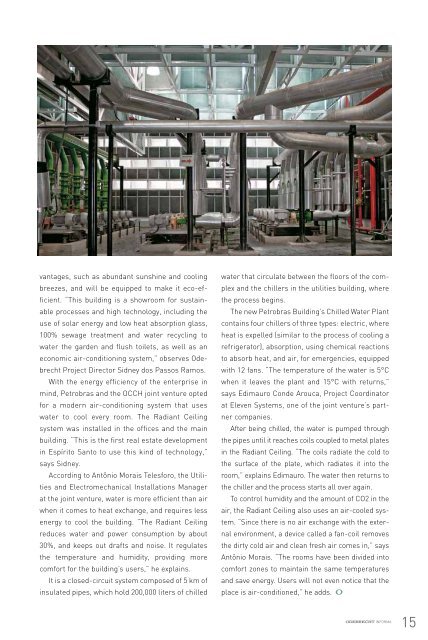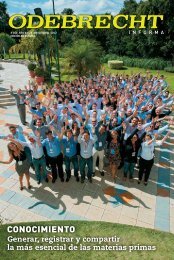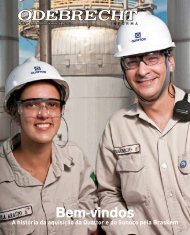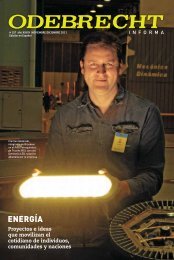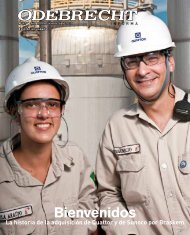ENERGY - Odebrecht Informa
ENERGY - Odebrecht Informa
ENERGY - Odebrecht Informa
Create successful ePaper yourself
Turn your PDF publications into a flip-book with our unique Google optimized e-Paper software.
vantages, such as abundant sunshine and cooling<br />
breezes, and will be equipped to make it eco-efficient.<br />
“This building is a showroom for sustainable<br />
processes and high technology, including the<br />
use of solar energy and low heat absorption glass,<br />
100% sewage treatment and water recycling to<br />
water the garden and flush toilets, as well as an<br />
economic air-conditioning system,” observes <strong>Odebrecht</strong><br />
Project Director Sidney dos Passos Ramos.<br />
With the energy efficiency of the enterprise in<br />
mind, Petrobras and the OCCH joint venture opted<br />
for a modern air-conditioning system that uses<br />
water to cool every room. The Radiant Ceiling<br />
system was installed in the offices and the main<br />
building. “This is the first real estate development<br />
in Espírito Santo to use this kind of technology,”<br />
says Sidney.<br />
According to Antônio Morais Telesforo, the Utilities<br />
and Electromechanical Installations Manager<br />
at the joint venture, water is more efficient than air<br />
when it comes to heat exchange, and requires less<br />
energy to cool the building. “The Radiant Ceiling<br />
reduces water and power consumption by about<br />
30%, and keeps out drafts and noise. It regulates<br />
the temperature and humidity, providing more<br />
comfort for the building’s users,” he explains.<br />
It is a closed-circuit system composed of 5 km of<br />
insulated pipes, which hold 200,000 liters of chilled<br />
water that circulate between the floors of the complex<br />
and the chillers in the utilities building, where<br />
the process begins.<br />
The new Petrobras Building’s Chilled Water Plant<br />
contains four chillers of three types: electric, where<br />
heat is expelled (similar to the process of cooling a<br />
refrigerator), absorption, using chemical reactions<br />
to absorb heat, and air, for emergencies, equipped<br />
with 12 fans. “The temperature of the water is 5°C<br />
when it leaves the plant and 15°C with returns,”<br />
says Edimauro Conde Arouca, Project Coordinator<br />
at Eleven Systems, one of the joint venture’s partner<br />
companies.<br />
After being chilled, the water is pumped through<br />
the pipes until it reaches coils coupled to metal plates<br />
in the Radiant Ceiling. “The coils radiate the cold to<br />
the surface of the plate, which radiates it into the<br />
room,” explains Edimauro. The water then returns to<br />
the chiller and the process starts all over again.<br />
To control humidity and the amount of CO2 in the<br />
air, the Radiant Ceiling also uses an air-cooled system.<br />
“Since there is no air exchange with the external<br />
environment, a device called a fan-coil removes<br />
the dirty cold air and clean fresh air comes in,” says<br />
Antônio Morais. “The rooms have been divided into<br />
comfort zones to maintain the same temperatures<br />
and save energy. Users will not even notice that the<br />
place is air-conditioned,” he adds.<br />
informa<br />
15


